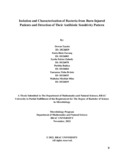Isolation and characterization of bacteria from burn-injured patients and detection of their antibiotic sensitivity pattern
Date
2022-11Publisher
Brac UniversityAuthor
Tanzin, DewanBinte Farooq, Faria
Zahedy, Syeda Fairuz
Baidya, Purbita
Brinto, Tamanna Tisha
Mim, Mahsina Moshiat
Metadata
Show full item recordAbstract
Burn injuries are one of the most prevalent public health issues and cause more than 26,000 deaths
every year all over the world. Burn injuries are skin or tissue damages that are caused by various
agents like fire, electricity, and chemical exposures. The study aimed to identify the microbial
profile of burn wound infections in burn patients and their resistance pattern against antibiotics. A
total of 104 burn-infected bacterial samples were collected and analyzed against 11 antibiotics of
different groups. In this study, a total of 104 samples of both male and female patients with an age
range of 1-90 were observed. It was found that among the 104 isolates burn infection in males was
67 (64.42%) and females were 37 (35.58%). The percentage of burn-injured patients in males was
higher than in females. Out of 104 samples, Gram-positive cocci accounted for 30 (28.85%) and
Gram-negative Bacilli accounted for 74 (71.15%) which in comparison is approximately double
of total Gram-positive isolates. In the case of gram-negative bacteria, the most prevalent bacteria
were Pseudomonas spp. 43(41.34%) and in the case of gram-positive bacteria, it was
Staphylococcus spp. 15(14.42%). Other than Staphylococcus spp, Staphylococcus saprophyticus
7(6.73%), Micrococcus spp. 7(6.73%) and Streptococcus spp. 1(0.96%) were also found. After
performing the antibiotic susceptibility test, both gram-positive and gram-negative bacteria
showed 100% resistance to the penicillin class of antibiotic. Colistin sulfate and Azithromycin
showed the least resistance to Pseudomonas spp which was 13.51% and 32.43% respectively. In
terms of gram-positive bacteria, meropenem and imipenem showed the least resistance, which was
43.3%. Based on their resistance pattern bacterial isolates were classified into multidrug-resistant
(MDR), extensively drug-resistant (XDR), and pan-drug resistant (PDR) pathogens, 33(31.73%)
were MDR, 58(55.76%) were XDR and 10(9.61%) were PDR. Lastly, the minimum inhibitory
concentration (MIC) test was performed on ceftriaxone, levofloxacin, and vancomycin antibiotics
against some of the MDR strains. This data reveals that the MIC value rises beyond the standard
when resistant bacteria become less sensitive to these medicines.
This study will help the treatment process by providing proper antibiotics in advance without
waiting for culture, thereby reducing infection-related morbidity and mortality.

